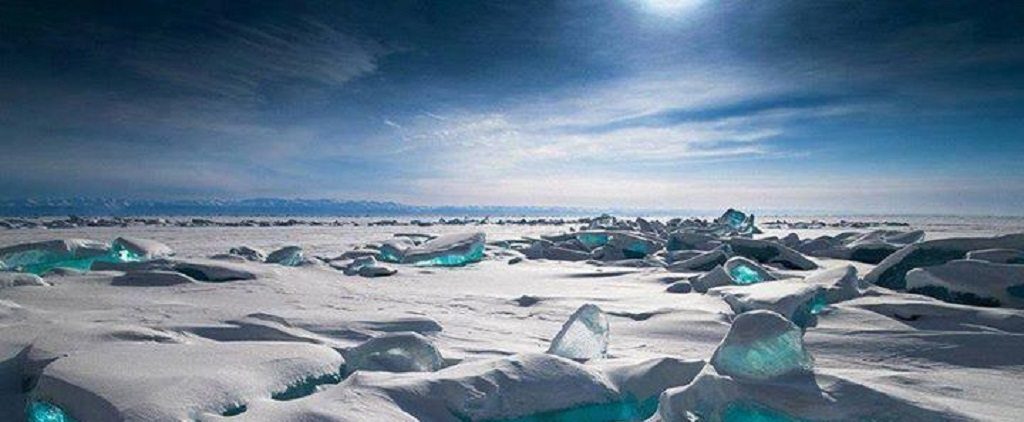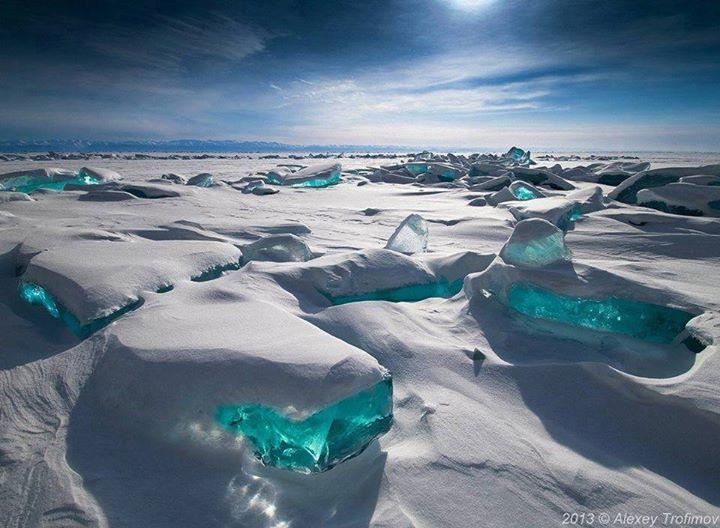[dropcap style=”font-size:100px; color:#992211;”]W[/dropcap]eirdly, lake ecologists involved in charting aquatic ecosystems tend to see winter as a dormant period and up sticks back to the comfy environs of the senior common room bar for the duration.
Weirdly, we say, because that would suggest that they do the majority of their research in the summer months, which is the traditional period for academics to be in Tuscany drinking bathloads of Chianti and getting around the outside of artisanaly-produced processed pig products.
Never mind, we only ran the story as an excuse to print that exquisite photo of snowcapped ice blocks on Lake Baikal.
As long as ecologists have studied temperate lakes, the winter has been their off-season. It’s difficult, even dangerous, to look under the ice, and they figured plants, animals and algae weren’t doing much in the dark and cold anyway.
But an international team of 62 scientists looking at more than 100 lakes has concluded that life under the ice is vibrant, complex and surprisingly active. Their findings stand to complicate the understanding of freshwater systems just as climate change is warming lakes around the planet.
“As ice seasons are getting shorter around the world, we are losing ice without a deep understanding of what we are losing,” said Stephanie Hampton, a Washington State University professor and lead author of a study published in the journal Ecology Letters. “Food for fish, the chemical processes that affect their oxygen and greenhouse gas emissions will shift as ice recedes.”
“A lake doesn’t go to sleep when it’s covered with a blanket of ice and snow,” said Liz Blood, program director in the National Science Foundation’s Division of Environmental Biology, which funded the research. “While winter’s lower temperatures and light levels may force lake life into a slower mode, algae and zooplankton are still abundant.
“What will happen if lake ice cover decreases in warming temperatures?” she said. “These results are a significant step in understanding what may be far-reaching changes for lake ecosystems.”
Fresh water is fundamental to society. We use it for drinking, manufacturing, energy production, irrigation and fish – a particularly important protein source in the developing world. Global warming is expected to change what we value in fresh water, as a study co-authored by Hampton last year found lakes warming around the world.
The new study finds that what happens in the winter can have a substantial effect on what happens during the rest of the year. This is especially true for lakes that let in a lot of sunlight, stimulating the growth of algae and zooplankton on the underside of the ice. These in turn serve as food sources for fish at the start of their growing season.
“In some lakes where the ice is really clear and there’s not very much snow cover, there can be a lot of photosynthesis and a lot of productivity,” said Hampton, who has extensive experience studying Lake Baikal in Russia, the world’s deepest lake. “So there were some lakes in this study where the productivity in winter actually exceeded the productivity you would see in summer.”
‘Unique little microecosystem’
Hampton said her Russian colleagues have seen “a unique little microecosystem” under the ice, with filaments hanging down from the subsurface.
“It’s interesting to think about these lakes that get a lot of light through the ice,” she said. “Russian researchers who spend a lot of time on Baikal remind us that when you get ice, now you’ve got a new habitat. It can be a vast habitat extending across the entire lake.”
Marine biologists have documented a key role of sea ice in supporting polar food webs.
“Under sea ice, you see the growth of foods higher in beneficial fatty acids and contributions as high as 30 percent to overall annual productivity,” said Oregon Institute of Marine Biology’s Aaron Galloway, a coauthor who was a postdoctoral fellow at WSU when the study began.
But until this study, freshwater scientists “were not able to make any sort of estimates like that at all,” said Hampton. Investigations of frozen freshwater bodies were just too spotty. Indeed, the International Society of Limnology’s Plankton Ecology Group, which has been highly influential in aquatic science, has developed a theoretical model of lakes incorporating the interplay of plankton, nutrients, temperatures and mixing. But in 2011 the group said, in effect, that winter was being overlooked.
“It was a pretty strong statement about how little we know about winter,” said Hampton.
140 sets of measurements assessed
So she and her fellow lake ecologists posted a request for data on a listserv of professional colleagues, expecting maybe 30 responses. They got 140 responses from researchers with measurements of various winter conditions, like plankton and nutrient levels, that could be compared to summer values.
Their findings varied a lot, often depending on whether a lake was covered with clear ice or covered with snow that blocked most light.
“In some cases, we know that zooplankton under ice are really important for seeding the populations that will take off in the summer and grow to be more abundant,” said Hampton. In other cases, there may be algae consuming large amounts of nutrients under the ice so the summer algae have less for their own growth.
Effects of climate change
Climate change stands to introduce another set of considerations.
“A number of things are changing, with climate change, that actually affect the characteristics of the ice itself,” Hampton said. The ice season can be shorter. There can be less snow, which will let in more light. Or there can be more rain during ice formation, making the ice cloudy.
Predicting these changes, she said, “will not be straightforward.”
Regardless, lake scientists will need to break out their winter gear.
“Overall, this study tells us that limnologists no longer have any off-season,” Hampton said. “No more down time, especially as we’re losing ice so rapidly.”
Source: Eurekalert/Washington State University
Image: Alexey Trofimov

Some of the news that we find inspiring, diverting, wrong or so very right.





















